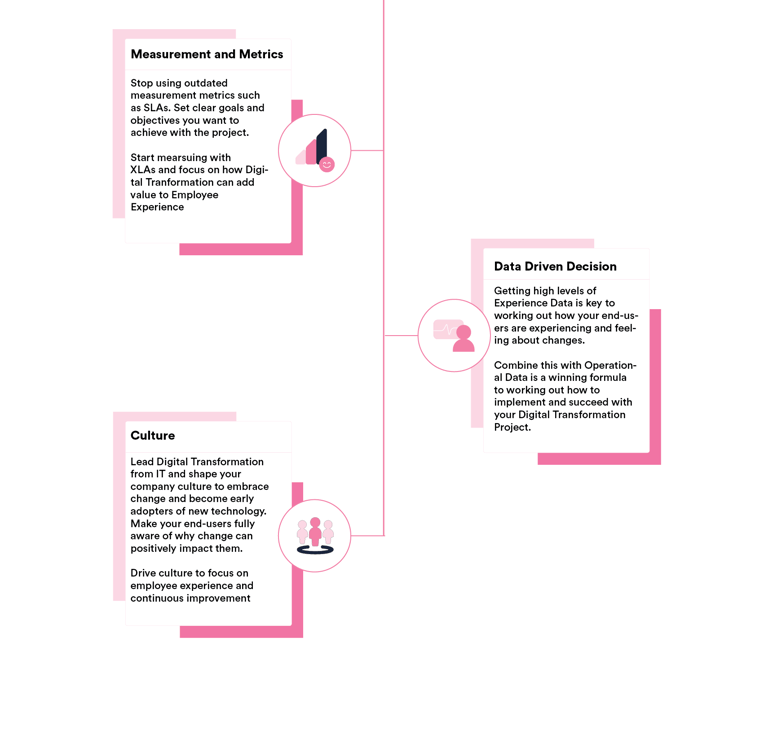What is Digital Transformation?
Digital Transformation can be seen as turning traditional processes to digital, which has arisen since the new technology era of the 1980s.
In the modern era however, where everything is digital, companies look to keep updating processes, services and workflows to keep adding value to end-users.
AiMultiple defines Digital Transformation as “the use of the latest technologies to enhance existing processes and offer new and improved services and products to customers. It aims to create value by changing how businesses operate and how they deliver value to customers”.
Why 70% of Digital Transformation projects fail
A study from Forbes and McKinsey showed that a total of $900 billion was wasted 2018 solely on digital transformation projects and a whopping 70% of digital transformation projects fail.
Boston Consulting Group conducted their own research in 2020 and found the same 70% failure rate.
HappySignals aims to provide the toolkit to gather insights that lead to successful Digital Transformation projects, by measuring and providing insights into end-user needs.
The business case for our motto "More smiles, less time wasted" is clearly visible in the BCG findings.
"
Digital leaders achieve earnings growth that is 1.8 times higher than digital laggards—and more than double the growth in total enterprise value." -Boston Consulting Group
HappySignals Approach to Digital Transformation

Digital Transformation Measurement and Metrics
Sami believes that Digital Transformation projects are launched in the wrong way. The first step to starting a digital transformation project is to “ask from the project managers and even the whole team one relevant question – what is the target or desired outcome for this project?” – Sami Kallio.
Creating a goal or desired outcome for a digital transformation project leads you to think about how you should be measuring the project, and this doesn’t mean basic/traditional SLA measurement metrics such as time, costs and budget.
“Digital Transformation is a really lovely concept, because it’s telling about a journey”
- Sami Kallio, CEO of HappySignals
Whatever reason you are undertaking your Digital Transformation project, your measurement needs to focus on the impact of the outcome and the value of employee experience and how the project can lead end-users to better processes, straightforward workflows and more importantly, an increase in productivity. This way of measurement is called Experience Level Agreements (XLAs).
Examples of Digital Transformation goals could be:
- Creating easier and quicker workflows to increase employee experience
- Increase employee productivity by X%
- Improve collaboration with the Service Desk to increase the quality of service given to end-users
- Increasing remote working efficiency so end-user can access office tools quicker
“You are having this journey because you want to change the way people do work, which will improve the employee experience and the productivity”
– Pasi Nikkanen, CPO of HappySignals
One of our clients Avanti West Coast (previously known as Virgin Trains) approach projects by taking half a day to define what they actually want to achieve from the project and how this will impact their employees or customers.
Sami says “That kind of thinking mindset is a totally different thing. And that helps to also focus on the value of the projects".
To put it in simpler terms - Digital Transformation should be measured on how it impacts the Employee Experience, not solely on whether the project was on-time or within the budget.
Data Driven Decision Making with Experience Data
Employee Experience, a massive trend that has gathered strength over recent years, and this should be the main outcome of any Digital Transformation project.
However, in order to create a successful project and truly positively impact the Employee Experience, we must start by gathering and analysing end-users needs and pain points, through experience data.
HappySignals IT Experience Management Platform allows you to collect end-users experience data and combine that with your companies operational data, to identify where you can truly impact your employee’s experience with Digital Transformation.
Campari Group embarked on a vast Digital Transformation journey and needed visibility on how the rapid transformation would affect employees and how transforming IT services would support end-users work.
Now, with HappySignals XMP, Campari Group has full visibility on their IT service performance and can make informed decisions throughout their transformational journey.
They can link it very clearly into when actions or services are going live in different locations and get immediate feedback from employees. Campari has also witnessed a high response rate due to the way the survey is delivered to the end-user.
Through HappySignals, you are able to collect valuable feedback from how your end-users experience changes and services, allowing you to make data-driven decisions instead of acting of gut feelings of what you think needs changing.
Culture in Digital Transformation Projects
Culture can impact Digital Transformation in many different ways, therefore understanding the different impacts of your business culture and what to prepare for is vital when planning your Digital Transformation strategy.
First of all, Digital Transformation needs to be led from the IT department, not by individual business units. This may seem an obvious statement due to the fact that IT usually fronts the cost of Digital Transformation projects, however it is often found that individual business sections will lead implementation.
Creating a culture that is ready to embrace change, new innovations and understand why this transformation is taking place, will be highly impactful for success. Adopting new technologies early can help drive your company culture to become more forward thinking as well as an understanding of new trending tech or new innovations arising on the horizon.
For example, Automation and AI are key trends for 2020 according to TopDesk (https://blog.topdesk.com/en/itsm-trends-2020) and can drastically reduce costs, free up budget for further investment in technology, as well as streamline tedious workflows that have been previously demoralising your workforce and diminishing productivity.
Culture also relates to the way people work and the processes they are used to when carrying out their daily business activities. Therefore if they are heavily reliant on using certain workflows or processes they could be resilient against change and may not understand why change needs to happen.
In an interview with one of our customers, the Head of Global Service Management for RB, Prashant Arora, said that when changes are being made to IT infrastructure, developing new processes or implementing strategy, they create a communication plan including monthly newsletters to make people more aware of what is happening as well as the reason how this change can impact them positively.
In Summary
A Digital Transformation Project should always begin with discovery sessions on why this project in being undertaken and how it can shape and influence a better employee experience.
Once this goal has been created, setting the right measurements and metrics is vital to continuously measure changes throughout the digital transformation.
The use of Experience Data is becoming an integral part of digital transformation projects as it enables you to measure and identify where your end-users' pain points are as well as how to improve their overall IT experience.




